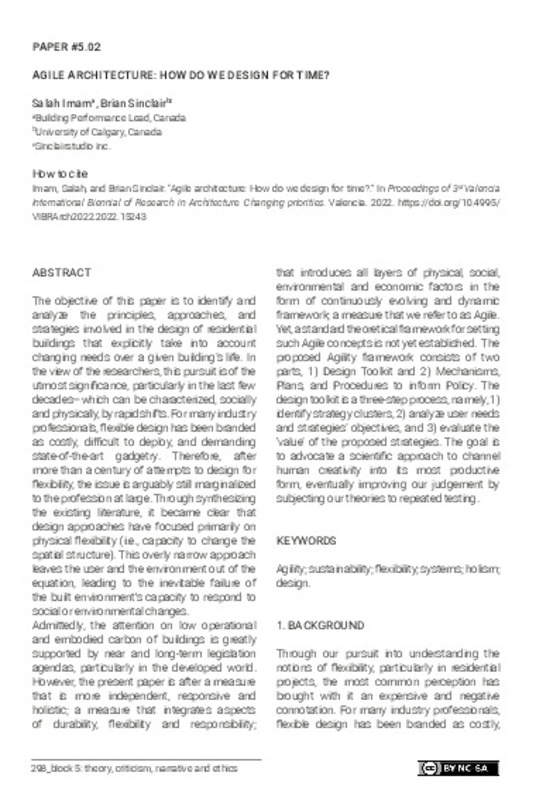JavaScript is disabled for your browser. Some features of this site may not work without it.
Buscar en RiuNet
Listar
Mi cuenta
Estadísticas
Ayuda RiuNet
Admin. UPV
Agile architecture: How do we design for time?
Mostrar el registro sencillo del ítem
Ficheros en el ítem
| dc.contributor.author | Imam, Salah
|
es_ES |
| dc.contributor.author | Sinclair, Brian
|
es_ES |
| dc.date.accessioned | 2023-12-19T08:36:22Z | |
| dc.date.available | 2023-12-19T08:36:22Z | |
| dc.date.issued | 2023-05-22 | |
| dc.identifier.isbn | 9788413960265 | |
| dc.identifier.uri | http://hdl.handle.net/10251/200896 | |
| dc.description.abstract | [EN] The objective of this paper is to identify and analyze the principles, approaches, and strategies involved in the design of residential buildings that explicitly take into account changing needs over a given building’s life. In the view of the researchers, this pursuit is of the utmost significance, particularly in the last few decades—which can be characterized, socially and physically, by rapid shifts. For many industry professionals, flexible design has been branded as costly, difficult to deploy, and demanding state-of-the-art gadgetry. Therefore, after more than a century of attempts to design for flexibility, the issue is arguably still marginalized to the profession at large. Through synthesizing the existing literature, it became clear that design approaches have focused primarily on physical flexibility (i.e., capacity to change the spatial structure). This overly narrow approach leaves the user and the environment out of the equation, leading to the inevitable failure of the built environment's capacity to respond to social or environmental changes.Admittedly, the attention on low operational and embodied carbon of buildings is greatly supported by near and long-term legislation agendas, particularly in the developed world. However, the present paper is after a measure that is more independent, responsive and holistic; a measure that integrates aspects of durability, flexibility and responsibility; that introduces all layers of physical, social, environmental and economic factors in the form of continuously evolving and dynamic framework; a measure that we refer to as Agile. Yet, a standard theoretical framework for setting such Agile concepts is not yet established. The proposed Agility framework consists of two parts, 1) Design Toolkit and 2) Mechanisms, Plans, and Procedures to inform Policy. The design toolkit is a three-step process, namely, 1) identify strategy clusters, 2) analyze user needs and strategies’ objectives, and 3) evaluate the ‘value’ of the proposed strategies. The goal is to advocate a scientific approach to channel human creativity into its most productive form, eventually improving our judgement by subjecting our theories to repeated testing. | es_ES |
| dc.format.extent | 12 | es_ES |
| dc.language | Inglés | es_ES |
| dc.publisher | Editorial Universitat Politècnica de València | es_ES |
| dc.relation.ispartof | Proceedings - 3rd Valencia International Biennial of Research in Architecture, VIBRArch | |
| dc.rights | Reconocimiento - No comercial - Compartir igual (by-nc-sa) | es_ES |
| dc.subject | Agility | es_ES |
| dc.subject | Sustainability | es_ES |
| dc.subject | Flexibility | es_ES |
| dc.subject | Systems | es_ES |
| dc.subject | Holism | es_ES |
| dc.subject | Design | es_ES |
| dc.title | Agile architecture: How do we design for time? | es_ES |
| dc.type | Capítulo de libro | es_ES |
| dc.type | Comunicación en congreso | es_ES |
| dc.identifier.doi | 10.4995/VIBRArch2022.2022.15243 | |
| dc.rights.accessRights | Abierto | es_ES |
| dc.description.bibliographicCitation | Imam, S.; Sinclair, B. (2023). Agile architecture: How do we design for time?. Editorial Universitat Politècnica de València. 298-309. https://doi.org/10.4995/VIBRArch2022.2022.15243 | es_ES |
| dc.description.accrualMethod | OCS | es_ES |
| dc.relation.conferencename | 3rd Valencia International Biennial of Research in Architecture, VIBRArch | es_ES |
| dc.relation.conferencedate | Noviembre 09-11, 2022 | es_ES |
| dc.relation.conferenceplace | Valencia, España | es_ES |
| dc.relation.publisherversion | http://ocs.editorial.upv.es/index.php/VIBRArch/VIBRArch2022/paper/view/15243 | es_ES |
| dc.description.upvformatpinicio | 298 | es_ES |
| dc.description.upvformatpfin | 309 | es_ES |
| dc.type.version | info:eu-repo/semantics/publishedVersion | es_ES |
| dc.relation.pasarela | OCS\15243 | es_ES |








